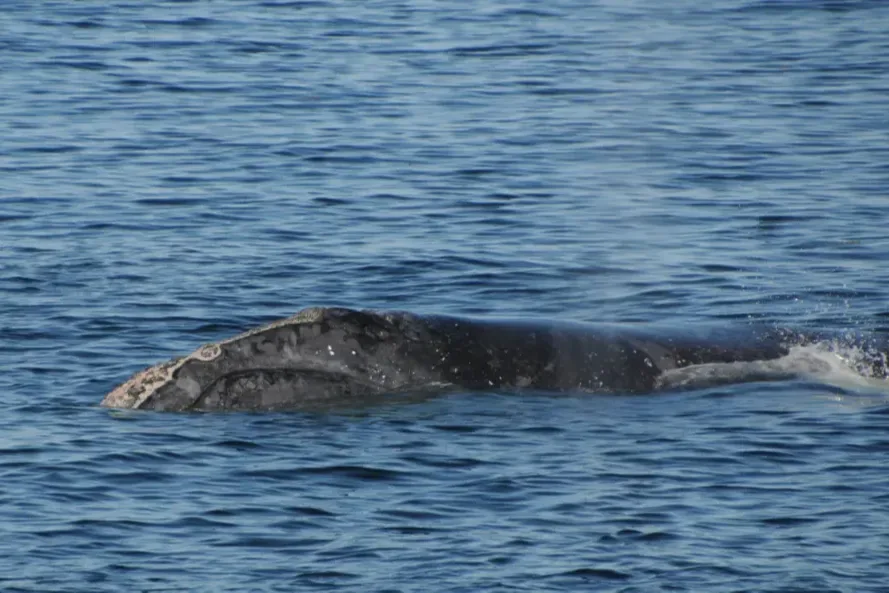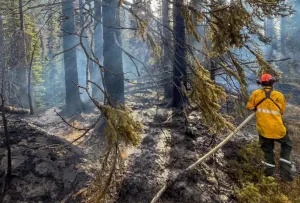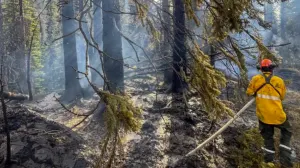
Why endangered North Atlantic right whales are given a moniker
With only 340 North Atlantic right whales left and even fewer reproducing females, scientist Philip Hamilton says catching the public's attention is key.
Hamilton is the senior scientist at the Kraus Marine Mammal Program in the Anderson Cabot Center for Ocean Life at the New England Aquarium.
SEE ALSO: New first-of-its-kind map reveals ‘whale superhighways’ throughout the oceans
"Having a name … I think can really help people feel a connection to the species that they might otherwise never see," he said. "Therefore if they feel a connection and they care, then they'll pay more attention to potential protective measures that are proposed."
Names were announced this week for 20 North Atlantic right whales and they're not random choices.
Hamilton said each North Atlantic right whale is named for a distinct feature, often connected to the patches of raised white tissue on their heads, known as callosity patterns.

Philip Hamilton, a New England Aquarium senior scientist, watches the tail of a whale in the distance. (Submitted by New England Aquarium)
These white bumps are like fingerprints, he said, and no two whales have the same pattern.
For example, a whale known as Vega has three white dots on the side of his head, and Hamilton said those dots reminded many in the right whale community of a star pattern known as the Summer Triangle, so Vega was named after one of those three stars.

Hamilton is the senior scientist at the Kraus Marine Mammal Program in the Anderson Cabot Center for Ocean Life at the New England Aquarium. He has been studying North Atlantic right whales for 35 years. (Submitted by New England Aquarium)
Jedi's callosity pattern was named for — you guessed it: Star Wars.
A name to go with the number
The right whales also have four-digit catalog numbers, but Hamilton said actual names makes it easier to identify them in the field, and it makes people care about them more.
Hamilton said there are different perspectives when it comes to naming animals in the wild. He said he understands concerns about anthropomorphism, the attribution of human characteristics to an animal.

Jedi was named for his callosity pattern, an array white dots, which resembles a Star Wars spaceship battle. (New England Aquarium under NOAA research permit #19674)
But he said they don't use human names for the whales, and for him, it's more important that people have ways to connect with the endangered species.
"It's way more important that these animals have advocates — I don't think they care if they have a name or a number," said Hamilton. "So it's more how the people are responding to it. And if it leads to advocacy, then I think it is well worth it."
Endangering factors
Snow Cone might be a familiar name to New Brunswickers, a North Atlantic right whale last spotted in the Gulf of St. Lawrence in September in extremely poor health, according to a New England Aquarium news release at the time.
Researchers called her death "all but certain." Snow Cone, who had been spotted entangled in fishing gear a few times, was seen with even more gear wrapped around her body during her last spotting.
She was one of under 100 reproducing females left and her death would mean the possible loss of her lineage since her first calf was killed by a boat and her second hadn't been seen since April, the release said.

A photo of Snow Cone and her calf taken on Jan. 6, 2022. The calf has not been seen since April. (Florida Fish and Wildlife Conservation Commission)
Hamilton said Snow Cone is a good example of why they name the whales.
"I think if we just use her catalog number, I don't think people would have been quite as moved by her story," he said. "It's a tragic story."
Hamilton said the number of North Atlantic right whales was growing until around 2010, when their numbers then started to "steeply" decline.
He said the reason is primarily entanglements, where the whale drowns or is caught in fishing gear for a long period of time then slowly dies from infection or starvation.
Ship strikes are another reason for this decrease in numbers, said Hamilton, killing or injuring the animal.
He said climate change has also had a direct impact, which caused the species to abandon three of its feeding habitats because of changes in the ocean currents.
WATCH: As sea temps rise these whales are leaving the Bay of Fundy in search of food
How to protect right whales
The Canadian government put protective measures in place when North Atlantic right whales were getting entangled at "a really alarming rate," said Hamilton.
These include the implementation of seasonal and temporary fishing closures in the Gulf of St. Lawrence, the Bay of Fundy and other critical habitat areas along with a speed restriction for all vessels over 13 metres throughout many areas in the Gulf of St. Lawrence
Hamilton said members of the public can support North Atlantic right whales by paying attention to what's happening to their population.
He said to pay attention to where your fish is coming from and ask questions about changes that could help protect the species.
"In the places where, for example, fishermen are adapting the way they fish to help protect right whales, you know, support those fishermen because that's the type of transition that is really needed for this species to continue."
WATCH: How a map could help keep mammals protected
The story, written by Hannah Rudderham, was originally published for CBC News.









